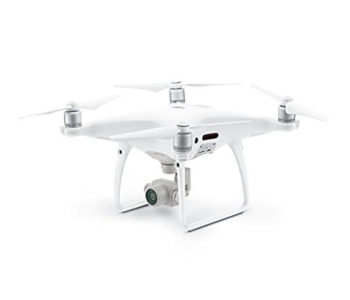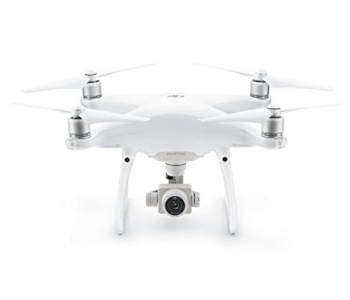Phantom 4 Pro Specs
The DJI Phantom 4 Pro is an advanced-level drone of the 4th generation Phantom 4 series. The Phantom product line is categorized by DJI as consumer drones which offer strong video quality. The Phantom 4 Pro drones, in particular, have all the signature technologies of DJI such as obstacle sensors, Lightbridge connectivity (Pro V2 has the newer OcuSync system), 4K video, 3-axis gimbal, and plenty of other useful features.
The Phantom 4 Pro drone was released in November 2016. This drone is suitable for everyone from a light user to an aspiring filmmaker. Recreational users, hobbyists, and semi-professional users find the depth of features of the Phantom 4 Pro to be quite manageable. Serious video professionals and filmmakers appreciate the professional-grade video capturing capability and the navigational capabilities of the Phantom 4 Pro drones.
The Phantom 4 Pro and the Phantom 4 Pro V2 are the two models at the highest end of the Phantom 4 series. They have similar specs for the most part, with differences on a couple of important metrics. Let us look at the specs in more detail:
Flight Speed
Both the DJI Phantom 4 Pro and the Pro V2 have a maximum flight speed of 45 miles per hour, which is roughly a shade over 72 kilometers per hour. This speed is normally obtained when using the sport mode. 45 mph is enough to shoot most kinds of video including basic action shots. Following objects and cars is also quite feasible with this speed. However, following a very fast moving car on a highway might be a challenge.
Flight Time
The DJI Phantom 4 Pro and the Phantom 4 Pro V2 have a maximum flight time of 30 minutes. This time limit is one of the highest among all the DJI drones. Only the Matrice 200 has a higher maximum flight time of 31 minutes. The Phantom 4 base model and other less advanced models have a flight time of 28 minutes. 30 minutes is pretty much as high a flight time as one can find in a consumer drone.
Weight
Phantom 4 Pro weighs 3.06 lbs or 1388 grams
Phantom 4 Pro V2 weighs 3.03 lbs or 1375 grams
Sensor Size
The DJI Phantom 4 Pro and the Phantom 4 Pro V2 both use a 1-inch CMOS sensor. This sensor size is larger than the 1/2.3 inches on the other Phantom 4 drones.
A larger sensor captures more information which, in turn, improves the signal-to-noise ratio, dynamic range, and other performance metrics. This sensor enables the camera to take 20-megapixel pictures.
Camera Specs

The Phantom 4 Pro and the Pro V2 have an electronic as well as a mechanical shutter. The use of a mechanical shutter helps eliminate what is known as rolling shutter distortion. This sort of distortion is observed in faster moving images, where either the object or the camera (drone body) is moving fast. A rolling shutter mechanism (as is the case with an electronic shutter) can cause such a distortion.
The camera on the Phantom 4 Pro and Pro V2 has an aperture range of f2.8 to f11, which is a very wide range, giving a good amount of image and video flexibility. There are 11.6 stops in this dynamic range.
Camera Video Resolution
The video resolution on a drone camera is very important. It determines the quality of the video which then gets shared/uploaded/submitted to a client. It represents the quality of work. Hence, a drone which has good controls and features also need to pack in high-level video resolution. The Phantom 4 Pro and the Pro V2 offer 4K video resolution at 60 frames per second.
Another bonus with the Phantom 4 Pro and the Pro V2 is the capability of H.264 and H.265 codecs. H265 video requires double the amount of processing but offers much better quality in return. The more recent iPhone and GoPro models have the capability to handle H.265 codec. However, older laptop models may have a hard time processing this new more advanced codec.
Below are the resolutions which the Phantom 4 Pro and the Pro V2 can achieve:
| Phantom 4 Pro | Phantom 4 Pro V2 |
|---|---|
| H.265 C4K: 4096×2160 24/25/30 p @100 Mbps 4K: 3840×2160 24/25/30 p @100 Mbps 2.7K: 2720×1530 24/25/30 p @65 Mbps 2.7K: 2720×1530 48/50/60 p @80 Mbps FHD: 1920×1080 24/25/30 p @50 Mbps FHD: 1920×1080 48/50/60 p @65 Mbps FHD: 1920×1080 120 p @100 Mbps HD: 1280×720 24/25/30 p @25 Mbps HD: 1280×720 48/50/60 p @35 Mbps HD: 1280×720 120 p @60 Mbps | H.265 C4K: 4096×2160 24/25/30 p @100 Mbps 4K: 3840×2160 24/25/30 p @100 Mbps 2.7K: 2720×1530 24/25/30 p @65 Mbps 2.7K: 2720×1530 48/50/60 p @80 Mbps FHD: 1920×1080 24/25/30 p @50 Mbps FHD: 1920×1080 48/50/60 p @65 Mbps FHD: 1920×1080 120 p @100 Mbps HD: 1280×720 24/25/30 p @25 Mbps HD: 1280×720 48/50/60 p @35 Mbps HD: 1280×720 120 p @60 Mbps |
| H.264 C4K: 4096×2160 24/25/30/48/50/60 p @100 Mbps 4K: 3840×2160 24/25/30/48/50/60 p @100 Mbps 2.7K: 2720×1530 24/25/30 p @80 Mbps 2.7K: 2720×1530 48/50/60 p @100 Mbps FHD: 1920×1080 24/25/30 p @60 Mbps FHD: 1920×1080 48/50/60 p @80 Mbps FHD: 1920×1080 120 p @100 Mbps HD: 1280×720 24/25/30 p @30 Mbps HD: 1280×720 48/50/60 p @45 Mbps HD: 1280×720 120 p @80 Mbps | H.264 C4K: 4096×2160 24/25/30/48/50/60 p @100 Mbps 4K: 3840×2160 24/25/30/48/50/60 p @100 Mbps 2.7K: 2720×1530 24/25/30 p @80 Mbps 2.7K: 2720×1530 48/50/60 p @100 Mbps FHD: 1920×1080 24/25/30 p @60 Mbps FHD: 1920×1080 48/50/60 p @80 Mbps FHD: 1920×1080 120 p @100 Mbps HD: 1280×720 24/25/30 p @30 Mbps HD: 1280×720 48/50/60 p @45 Mbps HD: 1280×720 120 p @80 Mbps |
Maximum Video Bitrate
The bitrate of the Phantom 4 Pro and Pro V2 drones is 100 Mbps. This is the highest bitrate among all the Phantom (or even Mavic) drones. The lesser advanced models have bitrates of 40 and 60 Mbps. A higher bitrate means better quality video. To put things into perspective, Blu-Ray has a bitrate of 25 Mbps. So, we are talking 4 times the quality of Blu-Ray.
Photo Format
When you shoot your pictures using a drone camera, you can normally store them as JPG or RAW format. However, the Phantom 4 Pro and the Pro V2 allow three options. This third option is JPG+RAW. That’s right, you can now store both JPG and RAW formats on your memory card so that you can browse through the JPGs and delete the pictures which aren’t right. You can then use the RAW files of the images which you kept and edit them using an image editing software. It just makes life a lot simpler than having to open each raw file one by one. Bear in mind that JPG+RAW will take up more memory storage since you are storing two files instead of one for each image.
Gimbal
Both the Phantom 4 Pro and the Pro V2 use a 3-axis gimbal (pitch, roll, yaw) with a controllable range of -90o to +30o.
Obstacle Sensors

The Phantom 4 base model and the Phantom 4 Advanced model have front and bottom sensors for obstacle sensing. The front sensors allow the drone to see far out in distance and avoid obstacles, hover around them, and even enable auto brake when flying certain paths or returning to home. It improves the intelligence of the navigation process.
The Phantom 4 Pro and the Pro V2 have a total of 5 sensors for obstacle sensing and 4 for obstacle avoidance. There are sensors on the front, back, bottom, and two additional side infrared sensors. The front, bottom, and side sensors give the drones a 4-direction obstacle avoidance capability. All the sensors including the back sensor can sense obstacles. This kind of all direction capability enables the Phantom 4 Pro and the Pro V2 to fly in tight spaces and undertake complex maneuvering on professional level projects.
Communication link between the drone and the controller
Most of the Phantom 4 drones including the Phantom 4 Pro use the Lightbrigde communication protocol to link the remote controller to the drone aircraft body. Lightbridge is a lot more advanced than Wi-Fi. It uses 2 separate links, one to communicate with the camera plus gimbal and the other to send and receive drone controls. That enhances the quality of the link and the overall controlling of the drone. The Phantom 4 Pro’s Lightbridge link is more advanced than a regular Lightbridge link since it uses a dual-signal link.
The Phantom 4 Pro V2 uses a more advanced OcuSync communication system. OcuSync allows the connection of multiple controllers and even DJI goggles. The OcuSync link connects via the 2.4 GHz band or the 5.8 GHz frequency band if the other one has weaker signal strength.
Built-in screen with the controller
The Phantom 4 Pro and the Pro V2 drones have the option of buying a controller with a built-in screen. With a built-in screen, there is no need for a mobile device or a tablet to control the drone settings and flight.
GPS
All Phantom 4 drones use a combination of GPS and GLONASS systems for redundancy and more accurate navigation.
Intelligent Flight Battery and Charger
Both the Phantom 4 Pro and the Pro V2 drones have a similar battery in the drone body. The specs for the battery are as follows:
| Energy | 89.2 Wh |
| Capacity | 5870 mAh |
| Voltage | 15.2 V |
| Max Charging Voltage | 17.4 V |
| Battery Type | LiPo 4S |
| Net Weight | 468 grams |
| Charging Temperature | 5oC – 40oC |
| Max Charging Power | 100 Watt |
The Charger Specs are also the same for both the models and are as below:
| Input | 100 – 240 V, 50/60 Hz, 1.4 A |
| Output | 17.5V – 0~5.7A |
| Voltage | 17.5 V |
| Rated Power | 100 Watt |
Remote Controller
The Phantom 4 Pro and the Pro V2 remote controllers use two frequencies, a 2.4 GHz band and a 5.8 GHz frequency band. The remote controller uses either one of the two depending on the operating conditions. A higher frequency band gives the controller a longer operating range. Sometimes, if one frequency band is facing interference from other signals or if the signal strength is weak, then the frequency band gets switched.
For the 2.4 GHz band, the FCC transmission distance is 7 km and the CE transmission distance is 3.5 km (CE distance is 4km for the Phantom Pro V2). For the 5.7 GHz band on the Phantom 4 Pro and the Pro V2, the FCC distance is 7 km, the CE distance is 2 km, and the SRRC distance is 5 km.
Operating Temperature
Both the remote controller and the aircraft of the Phantom 4 Pro and Pro V2 drones have an operating temperature range of 0oC to 40oC.

